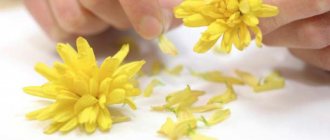Chrysanthemums are demanding in terms of light, temperature conditions and soil fertility, and the climate of the middle zone is not very favorable for their cultivation in open ground. But if you select varieties wisely and follow the rules of agricultural technology, you can get good results in our climate zone. The Korean varieties, colloquially called “oak trees” for their characteristic leaf shape, are best suited for this. Thanks to the efforts of breeders, they have high reproductive capacity, increased resistance to adverse environmental factors, diseases and pests, and bloom profusely and for a long time. These qualities have allowed oak trees to occupy one of the leading places in the range of ornamental crops in open ground. Cut Dutch hybrids can only be grown in a greenhouse.
Chrysanthemums - flower description
There are perennial and annual types of chrysanthemums, herbaceous and subshrubs. The shoots of chrysanthemums are always hard and straight, the leaves are arranged alternately.
Conventionally, all chrysanthemums can be divided into two types - large-flowered
(Indian) and
small-flowered
(Korean).
Large-flowered chrysanthemums
can only be grown in southern regions, greenhouses or conservatories - they are afraid of frost.
Korean chrysanthemums
They look very compact and beautiful.
Chrysanthemum is not a plant for lazy gardeners, as it requires constant care.
To obtain lush flowering of chrysanthemums, you need to water, feed, shape in time, divide, and take cuttings.
Popular varieties
Today there are more than 150 varieties of chrysanthemums. True, domestic gardeners prefer to grow their hybrids, which are distinguished by their durability, unpretentiousness and beauty. In addition, the care and planting of different varieties of chrysanthemums are practically the same, which greatly simplifies the task of gardeners.
In general, chrysanthemums have a rather complex classification, but the most popular types can be identified:
- Korean - small-flowered chrysanthemums, the size of the inflorescences ranges from 2-9 cm;
- Indian - large-flowered plants with flowers up to 10-25 cm in diameter;
- Japanese;
- Chinese.
In addition, chrysanthemums can have different flower structures. They are:
- semi-double;
- simple;
- terry;
- hemispherical;
- anemone-shaped;
- flat;
- curly;
- radiate;
- pom-pom.
And the leaves of flowers can be reed-shaped or tubular.
In our country, it is advisable to grow beautiful, unpretentious chrysanthemums that bloom for a long time. Large-flowered varieties are used to make bouquets and flower arrangements. But for planting in the garden, it is best to choose a small-flowered variety.
- Korean variety "Alyonushka". It has simple bright purple flowers with a diameter of up to 5-6 cm. Bushes can grow up to half a meter. Alyonushka begins to bloom in September.
- Korean variety "dune". It blooms with yellow-orange inflorescences with a diameter of up to 5 cm. This chrysanthemum can grow up to 60 cm.
- Bush variety "saba". It has very original, unusual colors: the middle of these flowers is green-yellow, and the petals are painted in a red-purple hue with a white edge. Looks amazing. The inflorescences of this variety reach a diameter of 5 cm, and the growth of the bushes is 0.7 m.
- Korean variety "snowball". It has beautiful double inflorescences with a diameter of about 5-6 cm, white with pink tips. Shrubs grow up to 60 cm.
- Korean variety "Mishal". Small-flowered double chrysanthemums, the size of the pompom inflorescences reaches 4-4.5 cm in diameter. The color of the flowers is bright yellow. "Michelle" begins to bloom in September, and its bushes reach a height of 40 cm.
- Korean variety "terracotta". It has double orange inflorescences with a diameter of 5-6 cm. The height of such bushes ranges from 50-60 cm.
As you can see, the choice is quite varied. So you can easily choose a suitable plant for yourself, which will delight you with its beauty and bright colors for almost six months.
Chrysanthemums - growing from seeds
The easiest way to propagate chrysanthemums is by dividing bushes and cuttings, but chrysanthemums are often grown from seeds.
When the threat of return frosts has passed, in May, chrysanthemum seeds are sown in open ground. The distance between plants is 20-25 cm. Make small holes, pour water and put 2-3 seeds in each, sprinkle with earth.
To preserve heat and moisture, cover the bed with film, which is removed as soon as the first shoots appear.
10 days after germination, feed the seedlings with complex mineral fertilizers. Remove weeds from the garden bed in a timely manner and loosen the soil after rains and watering.
When the seedlings are 7-10 cm tall, leave 1 seedling in each hole; the remaining shoots can be transplanted to another place. Such annual chrysanthemums will bloom in August. In order for flowers to appear earlier, it is necessary to grow chrysanthemums from seeds through seedlings.
Formation and pinching of chrysanthemums
When and correctly pinched, it is very important because it stimulates the development of side shoots, helping the chrysanthemum to form a lush bush and promoting its friendly flowering in the future. It is held throughout June. It should be taken into account that the period of time between the last pinching and the beginning of flowering should be about a month.
The number of axillary lateral buds must be constantly controlled by plucking. Since they overload the plant, there should be no more than 25-30 of them. To obtain inflorescences of maximum size on large-flowered varieties, only 2-3 of the strongest shoots with buds are left on them, and the rest are removed.
Large-flowered varieties are usually cultivated in one, rarely in 2-3 stems, and small-flowered varieties are usually grown in the form of bushes, less often on a trunk. In any case, the first buds of young chrysanthemums are removed. This is done so that the plant does not bloom too early and has time to get stronger. It is worth noting that recently more and more hybrid varieties have appeared that do not require thinning of the buds.
In large-flowered varieties, the abundance of side shoots and buds delays the development of the main bud, so they are removed as they appear. Excess buds are separated with the thumbs of both hands using horizontal movements.
Korean chrysanthemum “Ausma”
Tall varieties that reach a height of more than a meter need support. To do this, it is convenient to use pegs made of wood or metal, connected to each other with wire. You can make them yourself or purchase them at a garden store. Another way to support the plant is to attach a special net around it, at a height of about 40 cm from the ground. She will not allow the bush to decay. At first, the mesh does not look very aesthetically pleasing, but after a short time the chrysanthemum grows and the support becomes invisible.
Planting chrysanthemums in spring
Chrysanthemum seedlings are planted in the spring, when the threat of return frosts has passed - late May, early June.
The area for planting chrysanthemums should be well lit by the sun, without constant drafts and stagnant water.
Neutral or slightly acidic, loamy, nutritious soil is suitable for growing chrysanthemums.
Chrysanthemum does not like unrotted manure; it prefers vermicompost or compost, which is added to the planting hole.
It is better to plant in the evening or on a cloudy day, keeping a distance of 50 cm between plants - it all depends on the variety and type.
After planting and watering the plants, pinch, removing the top part (growing point) of the chrysanthemum. It is better to cover the seedlings with covering material to create a microclimate and better survival rate.
Selecting a site and soil for chrysanthemums in open ground
Proper selection of a planting site is very important for successful cultivation and care. How the plant survives the winter largely depends on it. Chrysanthemums love warmth; they grow in open sunny places, illuminated for at least 5 hours a day, protected from strong winds, with good drainage. Lack of lighting leads to weakening of plants, their flowering dates are shifted, and the inflorescences form ugly and dull in color. Such chrysanthemums have weakened immunity and low frost resistance.
Speaking about how to grow chrysanthemums outside, you need to understand that they grow best in organic-rich, loose, moisture-permeable, slightly acidic soil with a pH in the range of 5.5 - 7.0. To ensure that the soil for flowers meets these conditions, dry mullein and compost are added to it, but in reasonable quantities. If the soil is “overfertilized,” chrysanthemums will begin to actively increase green mass to the detriment of flowering. Organic additives are added to the soil in advance, in the fall, at the rate of 10 kg of organic matter per 1 square meter. m. It can be humus, peat or compost. As a last resort, you can cultivate and care for chrysanthemums in an area with peat soil, having previously reduced its acidity by liming and adding the nutrients necessary for the plant.
Drainage for chrysanthemums is also vital. Excessive moisture lingering in the soil does not allow the plant to survive the winter well. That is why they try to plant chrysanthemums in elevated areas. And to improve drainage, several buckets of coarse river sand are added to the soil for the future flower bed.
Propagation of chrysanthemums by cuttings
A simple way to propagate chrysanthemums is by cuttings. In the spring, when the daytime temperature is 22-26 degrees, use a sharp knife to cut cuttings from the mother plant (growing directly from the root of the chrysanthemum, and not lateral shoots). The length of the cutting should be 6-7 cm.
The substrate for planting cuttings must be prepared in advance.
The lower part of the cutting is dipped in a growth stimulator and planted in a container with nutrient soil, which is covered with sand to a depth of 12 cm, at an angle of 45 degrees.
The bottom of the cutting should remain in the sand without touching the soil. The cuttings are placed and rooted on a light windowsill, making sure that the soil is constantly moist. The temperature when rooting cuttings should be 15-18 degrees.
After 2-3 weeks, the cuttings form roots and can be planted in open ground.
Advice from experienced gardeners
There are some subtleties in planting chrysanthemums in the spring and subsequent care for them, which experienced gardeners are willing to share:
- When decorating a flowerbed in the spring, it is better to select varieties of chrysanthemums that have different dimensions. The tallest bushes are planted in the background, the lowest ones in front.
- For regions with cold climatic conditions, special zoned frost-resistant varieties are more suitable.
- It is better to dig up some especially valuable bushes for the winter and transplant them into a container. The remaining ones must be insulated by covering them with spruce branches or any agricultural material.
- In order for the inflorescences to be large and bright, it is necessary to feed the plants in a timely manner.
- This crop does not like soils with a high clay content because they retain moisture. In the spring, before planting, sand must be added to such soils.
- Properly selected spring varieties of chrysanthemums with different flowering periods will allow the flower garden to be beautiful all summer and autumn until frost.
Caring for chrysanthemums
For normal growth and abundant flowering, it is necessary to follow some rules when caring for orchids.
The main task is to pinch the seedlings in time, after the appearance of the 8th leaf, then do the same when side shoots appear. This will increase the branching of the plant, and it will take on a beautiful ball shape.
When growing large-flowered chrysanthemums, you need to do the following: on the main stem, it is better to remove the side shoots completely, leaving a few of the strongest ones.
Tall varieties of chrysanthemums
need tying; for this, various structures are used to hold the bush or a regular peg is used.
Chrysanthemums need abundant watering, otherwise the stems become woody and the flowers less attractive. Watering should be done only at the root.
Loosen the soil around the bushes and remove emerging weeds.
Chrysanthemums need feeding, the number of which should be at least 3 per season. The first feeding is carried out 6 weeks after planting, the rest at intervals of 3-4 weeks.
At the beginning of growth, it is necessary to apply more nitrogen-containing fertilizers for active growth and growth of green mass. At the beginning of bud formation and during flowering, chrysanthemums need phosphorus-potassium fertilizers more.
For organic fertilizers, you can use rotted cow manure or bird droppings.
Fertilizer recipe for garden chrysanthemums
To prepare healthy fertilizer, you need to take a large container and pour two buckets of mullein or one bucket of chicken manure into it. Then fill it with water and stir well. Leave the resulting solution in this form for three days.
Separately prepare the second part of the fertilizer. Mix a liter of concentrated infusion with 10 liters of water. Finally, combine both parts of the mixture and mix thoroughly. To feed, each plant needs a liter of this solution, which should be poured under the root. Just be sure to moisten the soil before doing this.
How to preserve chrysanthemums in winter
Heat-loving large-flowered varieties are afraid of frost and do not disappear in winter. Such varieties are usually dug out of the ground before frost (by selecting the mother bushes), placed in wooden boxes and stored in a cool room with a temperature of 2-6 degrees until spring.
Chrysanthemums are watered occasionally to keep the lump of earth moist.
Care after flowering
In order to increase the frost resistance of the bushes, in the first autumn weeks they are fed with phosphorus-potassium fertilizers for the last time during the season. Immediately after the first frost, for perennial chrysanthemums wintering in open ground (first of all, attention should be paid to varieties of Korean chrysanthemums with small inflorescences), the ground part is shortened to 10–15 centimeters from the ground surface. Then the bushes are well hilled, and the surface of the area is covered with a thick layer (from 0.3 to 0.4 m) of flying dry leaves. In regions with very frosty and little snowy winters, the mulch layer is covered with spruce branches or brushwood on top. Remember that covering the plant with material that does not allow air to pass through is extremely undesirable, because the bushes can move under it.
Wintering
Large-flowered, vigorous varieties are very thermophilic and therefore they are not able to overwinter in the ground when grown in mid-latitudes. However, they can be preserved, and many ways have been invented for this. For example, a bush is removed from the soil and, together with a lump of earth, placed in a box made of wood. Then it is transferred to a well-lit but cold room (from 2 to 6 degrees), while the air humidity should be at 80 percent. If there are few bushes, then individual containers are used for planting them. Water them systematically, making sure that the earthen ball is always a little damp.
For storage, dug up plants can be placed in a cellar, and the air temperature should be from 0 to 4 degrees. They are laid close to each other on the earthen floor along with clods of earth.
There is another way to preserve chrysanthemums. Dig a trench half a meter deep and arbitrary width in the garden plot, place the mother bushes in it and fill the distance between them with soil. The trench is not covered until frost, this will kill all pathogens of viral and fungal diseases. After the first frost, the top of the trench is covered with a wooden shield or simply boards, and you can also use slate or other hard materials. The shelter is covered with a layer of foliage, which is covered with soil. A covering material is laid on top of the earthen layer so that it is not blown away by a gust of wind; it is securely fixed. The disadvantage of this method is that you will not be able to check in winter what condition the plants are in.
It is important to know:
- small-flowered Korean chrysanthemums, as well as Russian hybrids, winter well in the garden;
- bushes that have grown in a greenhouse must be dug up in late autumn, just like large-flowered chrysanthemums, foreign hybrids and new varieties about which you know very little.
Wintering chrysanthemums in the middle zone. Website "Garden World"
Chrysanthemum diseases
Chrysanthemums can also be susceptible to various fungal diseases if the basic rules of agricultural technology are not followed:
- Powdery mildew affects leaves, shoots, buds, flowers and covers them with a white coating.
- Verticillium wilt, leading to yellowing of leaves and death of stems.
- rust, the above-ground parts of plants become covered with chlorotic spots that turn brown over time, resulting in yellowing of the leaves.
- gray rot leads to the appearance of brown spots, which over time become covered with a fluffy coating, which causes rotting of the plant.
Preparations containing copper can help in the treatment of fungal diseases - copper oxychloride, Bordeaux mixture, colloidal sulfur
.
Chrysanthemums are sometimes affected by viral diseases that are incurable and such plants must be promptly destroyed.
To exclude the possibility of infection with viral diseases, always use sterile instruments when cutting chrysanthemums.
How to properly care?
It doesn’t matter what kind of chrysanthemum grows on the site - pompom, spherical, terry or any other - all types require proper care. Without it, not a single variety will bloom and delight people with its beauty.
Even a novice gardener who has never cared for such plants before can easily cope with such procedures.
It is very important to provide the flower with regular and proper watering. Chrysanthemums are very sensitive to lack of moisture
If this plant is not watered enough, its flowers will be very small and sparse, and in some cases the stems may become woody. Excess water should also be avoided, because this will inevitably cause the chrysanthemum roots to begin to rot.
It is important to stick to the golden mean - the ground under the bush should always be a little damp. Be sure to monitor the weather conditions
In hot weather, you need to water the flower more often, and in cold weather - less often.
Chrysanthemums should not be left without mineral and organic fertilizers. It is recommended to apply mineral fertilizers every 2-3 weeks. During the growing season, fertilizers should contain more nitrogen, and in the future the emphasis will need to be on potassium and phosphorus.
Three times a season it is necessary to feed the chrysanthemum with mullein tincture. It must be diluted in a ratio of 1:10 with water. About 1 liter of prepared solution is poured under each bush. The next morning the soil must be loosened.
Pests of chrysanthemums
Nematodes most often cause damage to chrysanthemums - the appearance of mosaic spots on the leaves. Such plants must be removed from the site and destroyed. As a preventive measure against nematodes, before planting or digging up plants, treat them with Phosfamide solution.
Aphids are a pest of chrysanthemums, settling on the lower part of the leaves or in the buds, sucking the juice from the plants, inhibiting its growth and flowering. Infected plants must be treated with Aktara or Aktellik.
Slugs pose a danger to chrysanthemums; they can eat leaves, stems, and flowers.
Read more:
How to deal with slugs?
Varietal diversity
Currently, there are many varieties of bush chrysanthemums, among which are:
Chrysanthemum perennial
- Varieties in which only one row of petals participates in the frame of the calyx. Visually they are similar to chamomile.
- Cirrus chrysanthemums have double inflorescences. In flowers, the center is hidden under the petal part.
- Pompom-shaped varieties are characterized by small, completely double inflorescences. The shape of such flower stalks is spherical.
- The similarity between feathery and bristly varieties is visible to the naked eye. In the latter, the petal part is somewhat thinner, curved, similar to bristles, which gives it its name.
- In the anemone-like culture, only the middle part differs from the bristly one. It is slightly raised and curvy.
There are a large number of other chrysanthemum varieties that a gardener can grow in his garden.
Read more about chrysanthemum varieties: Perennial garden chrysanthemum varieties











